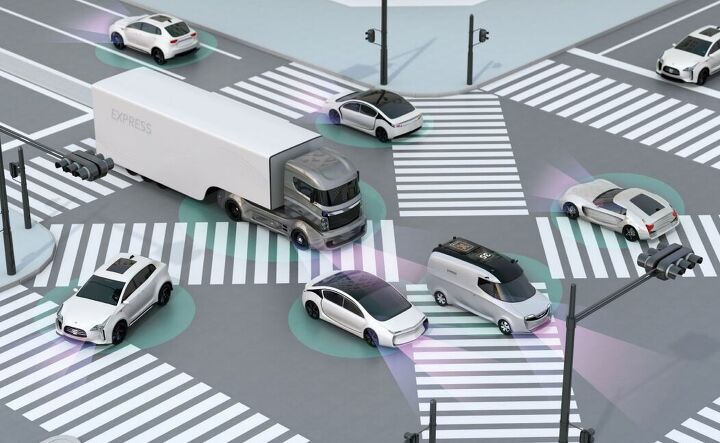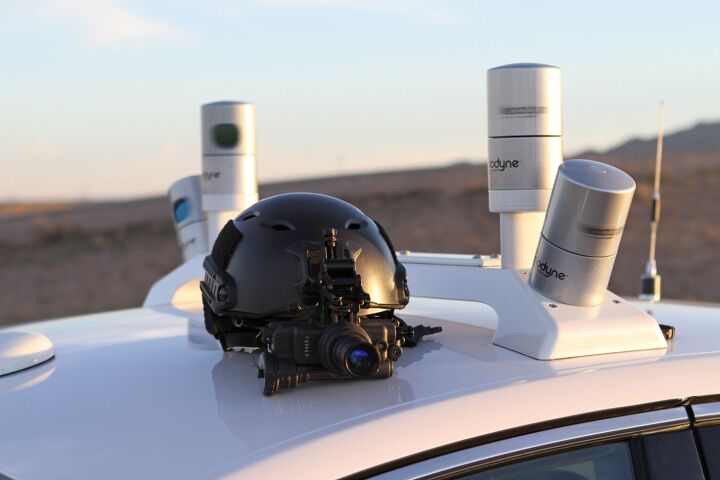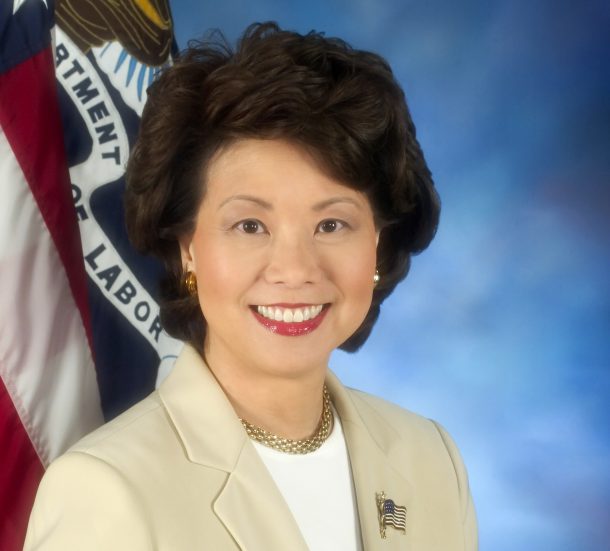#ElaineChao
GM Still Pushing Cars Without Steering Wheels, Talking With NHTSA
Remember when General Motors talked about delivering an autonomous vehicle, sans steering wheel or pedals, and how the Department of Transportation said Federal Motor Vehicle Safety Standards basically made it impossible? Well, GM hasn’t given up the fight to disassociate drivers from driving.
The U.S. National Highway Traffic Safety Administration has started talks with GM over the automaker’s petition to deploy a limited number of self-driving vehicles on American roads last Friday. Acting NHTSA Administrator James Owens told Reuters that the petition (issued in 2018) is currently under review.
“I expect we’re going to be able to move forward with these petitions soon — as soon as we can,” Owens said, suggesting a final decision would be made in 2020. “This will be a big deal because this will be the first such action that will be taken.”
U.S. Road Fatalities Declined in 2018
The National Highway Traffic Safety Administration announced Tuesday that American traffic deaths declined for a second year in a row in 2018. Data indicates a 2.4 percent decline in roadway fatalities last year, with bicyclists and pedestrians being the only groups to see risk moving in the wrong direction.
“This is encouraging news, but still far too many perished or were injured, and nearly all crashes are preventable, so much more work remains to be done to make America’s roads safer for everyone,” said U.S. Transportation Secretary Elaine Chao in a statement.
The DOT/NHTSA attributed improving automotive safety systems as the primary reason for the decline in deaths, though some of the metrics included in the report’s breakdown suggest other factors could be at play.
Attention Automakers: Ajit Pai is Not Your Friend
Two decades ago, the Federal Communications Commission decided to allocate a portion of the radio frequency spectrum for Dedicated Short Range Communications ( DSRC). The plan was to utilize that slice of the airwaves for ultra-modern automotive technologies relating to vehicle-to-vehicle and/or vehicle-to-infrastructure communications. Unfortunately, there hasn’t been a whole lot of activity on those channels.
The automotive industry was concerned it might need dedicated frequencies for use in autonomous-vehicle applications or some, yet unknown, technological advancement. But cable companies are annoyed that it’s being “wasted” and have started to antsy. They’ve asked the FCC to revoke carmakers’ exclusive rights to the frequencies and reallocate the majority of the 5.9-GHz band to the Wi-Fi systems that currently carry internet traffic for cable customers.
Hoping to encourage the commission to see things its way, Ford took FCC Chairman Ajit Pai out for a ride in an extra-special F-150 to plead its case. However, I feel like I can already predict whose side he’s going to take on this issue… and it isn’t going to be the automakers’.
Feds Abandoning 10 Self-driving Test Sites, Sticking With Voluntary Regulation
With Honda and General Motors teaming up on a self-driving car and GM’s Super Cruise getting the green light from Consumer Reports, it’s already been a busy week for automotive autonomy — and it’s only getting busier.
The U.S. Transportation Department plans to repudiate 10 locations previously outlined by the previous administration to serve as federally recognized proving grounds for self-driving vehicle tech. But don’t think for a second that this means the noose is tightening around the neck of autonomous testing. The Trump administration is preparing a new initiative that will lead to nationwide testing from just about anyone who can cobble together a vehicle with advanced driving aids.
EPA and NHTSA Officially Release Fuel Economy Plan, California Decidedly Pissed
After months of discussion, circulating drafts, and arguing with the State of California, the Environmental Protection Agency and National Highway Traffic Safety Administration formally unveiled their plan to rewrite the existing corporate average fuel economy (CAFE) rules and replace them with something far less stringent.
The proposal would freeze the presiding standards in 2020 under the “Safer Affordable Fuel-Efficient (SAFE) Vehicles Rule for Model Years 2021-2026 Passenger Cars and Light Trucks” plan, which is a mouthful.
It also moves to revoke California’s authority to set its own mandates, as predicted. The Golden State made it clear that it wants to maintain the Obama-era limits. However, the proposal includes a section emphasizing the importance of a single national standard, saying it would seek to withdraw the waiver granted to California in 2013.
“Attempting to solve climate change, even in part, through the Section 209 waiver provision is fundamentally different from that section’s original purpose of addressing smog-related air quality problems,” reads the proposal. “When California was merely trying to solve its air quality issues, there was a relatively-straightforward technology solution to the problems, implementation of which did not affect how consumers lived and drove.”
White House At Least Considering Increasing Gas Tax, Needs to Consult Congress
The United States’ 18.4-cent-per-gallon tax on gasoline and 24.4-cent tax on diesel hasn’t changed since 1993. Despite this, the opinion that it should be hiked as a way of funding public works was nowhere near the White House’s official infrastructure strategy. But Donald Trump isn’t averse to the idea. In fact, he proposed a 25-cent increase to senators during a Wednesday meeting as a possible funding solution.
White House officials claim the president says “everything is on the table” in terms of finding a solution for America’s growing infrastructure problems. But how serious the rest of the Trump administration is about raising the fuel tax is debatable.
NHTSA's Updated Autonomous Safety Guidance Doesn't Actually Offer Any
On Tuesday, Transportation Secretary Elaine Chao outlined the Trump administration’s “Vision for Safety 2.0” at the University of Michigan’s Transportation Research Institute in Ann Arbor. The document is a collection of non-binding requests to manufacturers and a promise that they can go hog-wild with their autonomous vehicle testing, at least as far as the feds are concerned.
In a deluge of policy updates, the National Highway Traffic Safety Administration tweaked its vision for safety, claiming it was responding to the recent increase in the number of road accidents.
While Obama-era guidelines weren’t particularly robust, the Trump administration has essentially built a technical-sounding framework aimed at destroying regulatory red tape. Ironically, the government seems to have gone out of its way to ensure it stays out of the way. In some respects, it has to. The speed of development is beginning to happen at a rate where any outside bureaucracy would have difficulty keeping pace. Chao said the guidance would remain flexible, ready to adapt to the changes as they come. But it is also without teeth, promoting development and the future promise for safety at the expense of any meaningful oversight.
Did the Department of Transportation and NHTSA sell themselves out to industry or do they actually think giving automakers carte blanche on autonomous testing was the best thing for public safety?
House Unanimously Approves Proposal to Deploy Self-driving Cars, and Not Everyone's Happy
On Wednesday, the U.S. House unanimously approved a sweeping proposal to expedite the deployment of self-driving cars and prohibit states from blocking autonomous vehicle testing.
“With this legislation, innovation can flourish without the heavy hand of government,” Ohio Republican Bob Latta said on the House floor leading up to Wednesday’s vote. Latta is chairman of the House Energy and Commerce subcommittee that developed the legislation with support from tech companies and the automotive industry.
One thing missing from the House measure is large trucks, which the Senate hopes to address in its own bipartisan legislation. Congress announced a September 13th hearing to examine the role of autonomous commercial vehicles and how they may fit into the Senate’s pending self-driving legislation. Meanwhile, the House’s bill moves up the board to be put to a vote within the Senate at a later date.
Trump Changes Regulatory Rules on Infrastructure, U.S. Waiting on Trillion Dollar Roadworks Plan
President Trump announced on Tuesday that he had signed an executive order to eliminate and streamline Obama-era regulations that might hinder the construction of U.S. roads and bridges. Absent, however, was any legislation regarding previous promises of allocating a trillion dollars revitalize the nation’s infrastructure.
While the press conference was mired by the weekend’s violence in Charlottesville, the topic eventually returned to roadworks and the aforementioned funding. “We will end up getting health care, but we’ll get the infrastructure, and actually infrastructure is something that I think we’ll have bipartisan support on,” Trump told reporters. “I actually think Democrats will go along with the infrastructure.”
Backed by Transportation Secretary Elaine L. Chao and Treasury Secretary Steven Mnuchin, Trump presented the media with a flow chart purporting to show the permitting regulations required to construct a highway in an unnamed state he claimed took 17 years under existing regulations.
New Transportation Secretary Has Obama's Self-driving Guidelines Under a Microscope
Last September, the Obama administration released a list of 15 guidelines to all automakers looking to develop and market a self-driving vehicle. Companies were asked to voluntarily follow the rules and report back to the federal government with useful information. It was a somewhat confusing exercise and raised a flurry of questions and concerns.
At the time, Obama wrote that the rules would provide “guidance that the manufacturers developing self-driving cars should follow to keep us safe.” Not only would the totally voluntary rules show the government that certain vehicles were safe for public roads, but it would show every interested citizen “how they’re doing it.”
That list is now in the hands of newly minted Transportation Secretary Elaine Chao. While the two administrations differ in many areas, Chao seems to be of a similar mind as Obama on the issue of self-driving cars. That doesn’t mean the guidelines won’t change.
Senate Confirms Trump's Pick for Transportation Secretary
The U.S. Senate voted ninety-three to six to confirm Elaine Chao as transportation secretary on Tuesday.
Chao, a former labor secretary and deputy transportation secretary, will face familiar issues while providing oversight on some new obstacles — specifically, autonomous vehicles and upholding President Trump’s promise to improve the nation’s infrastructure.
Trump Chooses Elaine Chao for Transportation Secretary
After much speculation, President-elect Donald Trump has chosen Elaine Chao, former labor secretary and current spouse of Senate Majority Leader Mitch McConnell, as his Secretary of Transportation.
House Majority Leader Kevin McCarthy spilled the beans, The New York Times reports, stating that the Trump camp named Chao for the role on Tuesday afternoon.



























Recent Comments